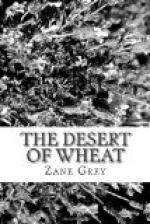“Come out an’ show me the wheat,” interrupted Anderson. “Lenore, do you want to go with us?”
“I do,” replied the daughter, and she took up her hat to put it on.
Kurt led them through the yard, out past the old barn, to the edge of the open slope where the wheat stretched away, down and up, as far as the eye could see.
CHAPTER II
“We’ve got over sixteen hundred acres in fallow ground, a half-section in rye, another half in wheat—Turkey Red—and this section you see, six hundred and forty acres, in Bluestem,” said Kurt.
Anderson’s keen eyes swept from near at hand to far away, down the gentle, billowy slope and up the far hillside. The wheat was two feet high, beginning to be thick and heavy at the heads, as if struggling to burst. A fragrant, dry, wheaty smell, mingled with dust, came on the soft summer breeze, and a faint silken rustle. The greenish, almost blue color near at hand gradually in the distance grew lighter, and then yellow, and finally took on a tinge of gold. There was a living spirit in that vast wheat-field.
“Dorn, it’s the finest wheat I’ve seen!” exclaimed Anderson, with the admiration of the farmer who aspired high. “In fact, it’s the only fine field of wheat I’ve seen since we left the foot-hills. How is that?”
“Late spring and dry weather,” replied Dorn. “Most of the farmers’ reports are poor. If we get rain over the Bend country we’ll have only an average yield this year. If we don’t get rain—then flat failure.”
Miss Anderson evinced an interest in the subject and she wanted to know why this particular field, identical with all the others for miles around, should have a promise of a magnificent crop when the others had no promise at all.
“This section lay fallow a long time,” replied Dorn. “Snow lasted here on this north slope quite a while. My father used a method of soil cultivation intended to conserve moisture. The seed wheat was especially selected. And if we have rain during the next ten days this section of Bluestem will yield fifty bushels to the acre.”
“Fifty bushels!” ejaculated Anderson.
“Bluestem? Why do you call it that when it’s green and yellow?” queried the girl.
“It’s a name. There are many varieties of wheat. Bluestem is best here in this desert country because it resists drought, it produces large yield, it does not break, and the flour-mills rate it very high. Bluestem is not good in wet soils.”
Anderson tramped along the edge of the field, peering down, here and there pulling a shaft of wheat and examining it. The girl gazed with dreamy eyes across the undulating sea. And Dorn watched her.
“We have a ranch—thousands of acres—but not like this,” she said.
“What’s the difference?” asked Dorn.
She appeared pensive and in doubt.
“I hardly know. What would you call this—this scene?”




